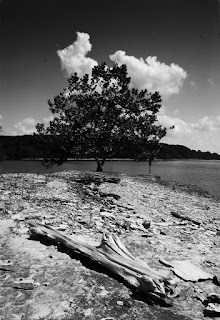 Trying to create a great photograph in the middle of the day with a bright blue sky and lots of sun is often like trying to drink from a firehose, too much of a potentially good thing. This is especially true for color photographs. The harsh light and shadows creates strong contrasts that are just not condusive to asthetically pleasing photographs. Color images require moody light which most often occurs early and late in the day. But, all is not hopeless for shooting in the middle of the day...if you think in Black and White.
Trying to create a great photograph in the middle of the day with a bright blue sky and lots of sun is often like trying to drink from a firehose, too much of a potentially good thing. This is especially true for color photographs. The harsh light and shadows creates strong contrasts that are just not condusive to asthetically pleasing photographs. Color images require moody light which most often occurs early and late in the day. But, all is not hopeless for shooting in the middle of the day...if you think in Black and White.Black and white photography is all about contrast, shape, and form. A blue sky day with bright sun is the perfect setting for black and white. Throw in some of those white puffy summer clouds and you have an Ansel Adams formula for great artistic expression.
There are many times I will shoot scenics in the middle of the day and when I do I am almost always thinking in terms of Black and White. I have in my book collection several Ansel Adams books and I am regularly browsing through them. Not only are his photographs incredible works of art, they are great instructional resources as well. A high percentage of his photographs were taken in the middle of the day. Most of them include those dramtic cloud formations against a black or almost black sky. I often wondered how he achieved that black sky look. Of course he accomplished this by using filters and various kinds of films and print paper along with darkroom techniques that enhanced that look. However, I discovered how relatively easy it is to duplicate this look in the modern digital world.
When shooting those big sky scenics I almost always use a polarizer filter. By itself it will reduce glare and darken a blue sky. When converting the image to black and white ( I use Silver Effects ) that blue sky will become very dark and when adding a bit of red filter processing and toning the blue values down, the sky begins to look a lot like Ansel's creations.









